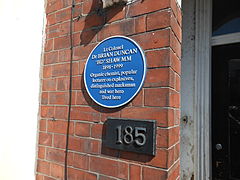Brian Duncan Shaw
Brian Duncan Shaw University College, Nottingham | |
|---|---|
| Spouses | Margaret Elsie Wheldon
(m. 1916)Alice Maud (m. 1990) |
| Awards | Frederic Stanley Kipping |
Lieutenant Colonel Brian Duncan Shaw, MM, TD (10 February 1898 – 7 November 1999) was a British chemistry lecturer at the University of Nottingham,[3] known for his demonstrations on explosives.[4]
Early and personal life
Shaw was born in Ilkeston, Derbyshire, the fourth and youngest child of Samuel Shaw and Lydia Emma Shaw, his brothers and sisters being named Lydia Emma, Mabel and Clarence Gordon. His father was a brick manufacturer and his mother had been working as a teacher.[5]
He started working at
In May 1916, he married his first wife, Margaret Elsie Wheldon.[6] After her death in 1990 he married Alice Maud on 5 June of the same year; she died in 1998, a year before Shaw himself.
Career
Military service
During the
He served with the 5th Battalion,
As a prisoner of war, Shaw took part in theatrical productions. Among other things he played the part of the ghost in Hamlet in a production at Tittmoning.
Academic career
Apart from a brief period as a Lecturer at the East London College, ending in 1923, B.D. Shaw spent his entire career as a lecturer in chemistry at University College in Nottingham, which from 1948 onwards was the University of Nottingham.
From 1930, he became known for the "Explosives Lecture" which demonstrated a large variety of ways to produce flashes and bangs using chemistry, including the barking dog reaction. He would continue to provide this lecture for a total of 60 years, extending long past his official retirement. In 1969, the Explosives Lecture was filmed by the BBC.[10]
He published several articles on pyridines, mainly in the Journal of the Chemical Society.[11][12][13][14][15][16]
After his retirement in 1965, he continued giving lectures and worked as an expert witness in several court cases, such as the defence of the
A blue plaque was installed on 16 November 2012 at his home.
The Shaw Medal
In 1988, the University of Nottingham created a medal in his honour called the Shaw Medal. Shaw himself was the first recipient of this prize.[3]
Gallery
-
The blue plaque located at the front door of its former residence at Queens Road, Beeston.
-
Shaw (left), 5th Battalion Sherwood Foresters at Bisley 1947, firing a Bren light machine gun. The 5th Battalion team won the 'China Cup', 'Velongdis Cup' and 'Lewis 9mm' cup at Bisley in 1947
-
Rare image of Dr Brian Duncan Shaw giving a practical demonstration of explosive chemistry at the age of 88.[22]
References
- ^ "'Official Gazette of United Kingdom', 15 August 2000". Archived from the original on 30 January 2015. Retrieved 30 January 2015.
- ^ "'Blue plaque for birthplace of Nottingham's famous explosives lecturer', 5 March 2015". 5 March 2015. Retrieved 16 March 2015.
- ^ a b c d "The Career of Lt. Col. Brian Duncan SHAW MM TD BSc PhD DSc", University of Nottingham. Retrieved on 30 January 2015.
- ^ It's a Blast! public lecture on explosives by Col B D Shaw, accessed 31 January 2015.
- ^ Brian Duncan shaw - Genealogy Chart - Boards - Genes Reunited, accessed 22 March 2015.
- ^ doi:10.1093/ref:odnb/73575. (Subscription or UK public library membershiprequired.)
- ^ London Gazette 28 June 1918,Supplement 30733, Page 7720 "Appointment as Temporary Lieutenant Lincolnshire Regiment".
- ^ "The Career of Colonel Brian Shaw". www.nottingham.ac.uk.
- ^ "Ten weeks in hiding". Nottingham Evening Post. 1 February 1941. p. 5. Retrieved 22 March 2015.
- ^ "The B.D. Shaw Lecture". University of Nottingham. 1999. Retrieved 13 September 2020.
- .
- .
- .
- .
- .
- .
- ^ Jones, David (28 November 1985). "Still going down like a bomb". New Scientist: 62–63. Retrieved 22 March 2015.
- YouTube. Retrieved 22 March 2015.
- ^ "Blue Plaques". 31 August 2014.
- ^ "Blue Plaques". www.beestonhistory.org.uk.
- YouTube. Retrieved 16 March 2015.
- ^ "Colonel Brian Shaw's Explosives Lecture".
Further reading
- Wilkes, Clare E. (2019). Framed by a smoking gun : the explosive life of Colonel B.D. Shaw. Kibworth: Book Guild Publishing. ISBN 9781912575473.
- Griffith, Bill (26 June 2020). "Framed by a Smoking Gun: The Explosive Life of Colonel B D Shaw". Chemistry World. Retrieved 20 October 2021.
External links
![]() Media related to Brian Duncan Shaw at Wikimedia Commons
Media related to Brian Duncan Shaw at Wikimedia Commons


